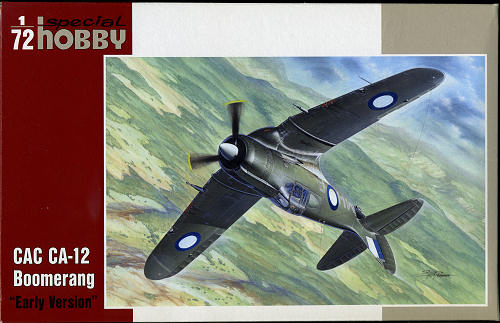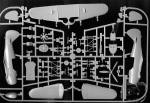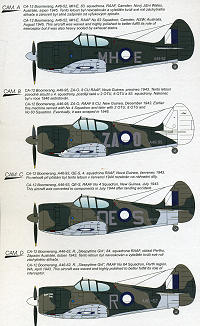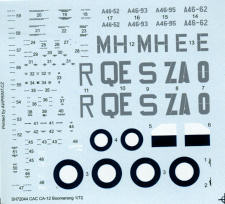
| KIT #: | 72044 |
| PRICE: | $25.00 SRP |
| DECALS: | Four options |
| REVIEWER: | Scott Van Aken |
| NOTES: | Short run. |

| HISTORY |
The CAC Boomerang was a World War II fighter aircraft designed and manufactured in Australia between 1942 and 1945. The Commonwealth Aircraft Corporation produced Boomerangs under the production contract numbers CA-12, CA-13, CA-14 and CA-19, with aircraft supplied under each subsequent contract incorporating modifications and improvements. The Boomerang is significant as the first combat aircraft designed and built in Australia.
Following the devastating first air raids on Darwin on 19 February 1942, the need for interceptors became more pressing. Despite the Boomerang's astonishingly short development phase — especially since the Australian aviation industry had never built fighters before, let alone designed them — by the time the Boomerang entered service, sufficient Curtiss P-40 Kittyhawks had arrived from the United States. In January 1943, these were replaced in the air defence role over Darwin by No. 1 (Fighter) Wing RAAF, which had returned from Europe, equipped with the Spitfire Mk Vc.
Two of the first three operational Boomerang units, No. 83 Squadron and No. 85 Squadron, were used for home defence. No. 84 Squadron was deployed to Horn Island in Torres Strait and Dutch New Guinea (West Papua), in an attempt to address the continuing shortage of fighters in this area. The squadron was only modestly successful however. The Boomerang's low top speed and poor high altitude performance meant that No. 84 Squadron could drive off enemy attacks but rarely get close enough to Japanese aircraft to bring their guns to bear. On the only occasion when a Boomerang did close with a Japanese aircraft, its guns jammed. Fortunately, there were not many air raids in this area, and after using Boomerangs for eight months No. 84 Squadron upgraded to the Kittyhawk.
The Boomerang found its real use as a close support aircraft. In contrast to Europe or North Africa, the ground war in the jungles of the south-west Pacific was, in broad terms, a series of small unit actions fought at very close quarters by widely dispersed forces with no clear front lines. It was here that the Boomerang found its niche: as close to the troops on the ground as possible.
It had the range to go wherever it was needed (usually the aircraft were based close to the area of ground operations), heavy armament by the standards of the day and, because it was easier to fly than most fighters, the pilot could get in close to the objective and have time to concentrate on the ground forces. Sprightly low-level handling helped avoid ground fire and rough terrain and the unusually extensive armour plating protected pilots. In addition, the aircraft's simple wood and aluminium airframe proved capable of absorbing battle damage. Nonetheless, several of the aircraft were shot down, including two accidental kills by US units, and more were damaged during landing accidents, as the Boomerang was prone to ground looping.
No. 4 Squadron and No. 5 Squadron flew Boomerangs in New Guinea, the Solomon Islands Campaign and Borneo Campaign, also in the close support role, with marked success. Flying in pairs (one to observe the ground, the other to observe the air around them), their tasks included bombing, strafing, close infantry support and artillery spotting. When attacking larger enemy formations Boomerangs often operated in conjunction with larger aircraft. In this role the Boomerang would get in close to confirm the identity of the target and mark it with a 20 lb (9 kg) smoke bomb with the "cooperating" aircraft delivering the major ordnance from a safer distance. The partnership between 5 Squadron Boomerangs and Royal New Zealand Air Force Corsair fighter bombers during the Bougainville Campaign was said to be particularly effective.
The other user of Boomerangs in New Guinea was No. 8 Communications Unit, which used the aircraft to assist with air sea rescue operations.
| THE KIT |
 Believe
it or not, this is only the second injection molded kit of the Boomerang in 1/72
scale. Your editor has built the other one by Airfix at least twice with the
most recent one being the best looking one, but despite a generally accurate
outline, it is an old Airfix kit and rather lacking in finesse. This one changes
all that.
Believe
it or not, this is only the second injection molded kit of the Boomerang in 1/72
scale. Your editor has built the other one by Airfix at least twice with the
most recent one being the best looking one, but despite a generally accurate
outline, it is an old Airfix kit and rather lacking in finesse. This one changes
all that.
It is a standard modern MPM/Special Hobby short run
kit with an injected canopy and a nicely done sprue of plastic (which is cut in
pieces to fit into the box). The aircraft is pretty basic and so it is with the
kit. The kit offers nicely done interior detailing in terms of additional
framework for the cockpit. A nicely done seat with backing frame, control stick
and control rod, rudder pedals and a nice instrument panel with mounting
framework. This will all be somewhat hidden by a one-piece canopy, though the adventurous can cut the kit canopy to see what is inside.
canopy, though the adventurous can cut the kit canopy to see what is inside.
The two row radial engine is well molded with push
rods having to be made by the builder. Though the rods are shown in the
instructions, no indication of the diameter or length is provided. For the main
gear wells, only the back wall/spar is provided, so one has to assume that the
rest of the well was open. The lone option is for a
 fuselage fuel
tank, which it butt fit to the underside. I dare say most of us will forego this
option as I am not sure it was actually used on ops. I should mention that this
version did not use the 'hedgehog' style exhaust.
fuselage fuel
tank, which it butt fit to the underside. I dare say most of us will forego this
option as I am not sure it was actually used on ops. I should mention that this
version did not use the 'hedgehog' style exhaust.
Markings are for four aircraft, all with a base of Foliage Green over Sky Blue. The initial aircraft was used as an interceptor in August 1945 with 83 squadron so was highly polished for additional speed. The other three options have a variegated Earth Brown pattern over the Green. The white tailed version is with 8 Squadron in New Guinea in 1943, Next is a 4 Squadron plane, also in New Guine during 1943, but before the white tail/leading edge requirements. Finally, an 84 Squadron plane based at Perth in 1943. This one is named 'Sleepytime Gal'. Decals are well printed and past experience shows them to be very thin.
| CONCLUSIONS |
Boomerang fans will want to relegate their Airfix kit to the sales box. This one very much supersedes the older one in all ways except for the number of parts.
| REFERENCES |
http://en.wikipedia.org/wiki/CA-12_Boomerang
I got this at Great Models' end of days sale
December 2012 If you would like your product reviewed fairly and fairly quickly, please contact the editor or see other details in the
Note to
Contributors.